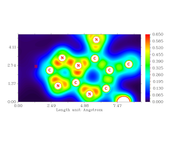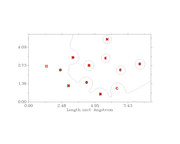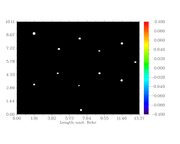Multiwfn forum
Multiwfn official website: http://sobereva.com/multiwfn. Multiwfn forum in Chinese: http://bbs.keinsci.com/wfn
You are not logged in.
- Topics: Active | Unanswered
Pages: 1
#1 Re: Multiwfn and wavefunction analysis » Plot difference map of electrostatic potential to study the binding » 2019-11-19 14:30:58
It seems that I need to more clarify the feature of the .chk file generated by ONIOM task of Gaussian.
For Gaussian, if ONIOM(H:L) keyword is used, where H and L correspond to the levels used for high layer and low layer, respectively, then the resulting .chk file only carries information of the real system (i.e. the whole system) calculated by L level. Therefore, if the L level is a molecular mechanics method, then the .chk file will not carry any wavefunction information; if the L level is a quantum chemistry method, the .chk file will contain MOs generated by this method. Because currently, the L level you used is a semi-empirical level, while semi-empirical wavefunction is not supported by Multiwfn, therefore any wavefunction analysis result obtained based on your .chk file is completely meaningless or fully misleading.
If what you want to study is the electronic structure of the atoms at high layer, you should manually extract the high layer structure and then perform a single point calculation to generate .chk file, which can then be normally used for wavefunction analysis by Multiwfn.
Thank you for the clarification about the .chk file, it is clear now and I will follow your suggestion. However, I have still some doubts if I can evaluate the influence of the residues involved in the binding extracting the high layer structure (ligand). I would try to study the non-covalent interaction between protein and ligand analysing the reduced-density-gradient, as you suggested. Thank you a lot again for your help.
Regards,
Carmine
#2 Re: Multiwfn and wavefunction analysis » Plot difference map of electrostatic potential to study the binding » 2019-11-18 10:02:35
Dear Tian,
Thank you for your quick reply and your help. here the input file lines:
%nprocshared=32
%mem=30GB
%chk=active_site_ligand.chk
# oniom(b3lyp/6-31+g(d,p):pm6) scrf=(cpcm,solvent=water,oniompcm=x)
scf=qc geom=connectivity
STRUCTURAL PROTEIN
I have only recently started to use Multiwfn, I usually use gaussview to analyse my results and I can visualize the ESP surface using it, but I would like to use Multiwfn, because I found it more versatile. I can plot the contour line map, but I found it less clear than coloured one, and I don’t have any problem for electron density (imagines attached). Here the command that I used in Multiwfn:
4 // Plot graph in a plane
12 // Total electrostatic potential
2 // Draw contour line map (or 1//Colour-filled map)
120,120 // Number of grids in each direction
4//Define by three atoms
Thank again for your help.
Off topic: Could me clarify the option gradient norm of electron density? Which info I can extrapolate from it?
Regards,
Carmine
#3 Multiwfn and wavefunction analysis » Plot difference map of electrostatic potential to study the binding » 2019-11-16 15:34:35
- CarmineV
- Replies: 5
Hi,
I have a problem when I plot the contour map of the electrostatic potential of my ligand in the pocket (imagine attached). Briefly, I would like to study the binding strength between the inhibitor and the protein active sites analyzing the electron density distribution and electrostatic potential maps. Although I do not have any problem to plot the electron density, I cannot achieve any good results using the electrostatic potential, I tried to change the scale, but still, I have a black image as output, any idea what is the problem? I am doing something wrong or it is the file calculation itself the problem? What else I can analyse to see a difference in the binding affinity of different ligands? For example the reduced density gradient? Just to give you some info, I have run two different jobs using gaussian: one just using the ligand alone (opt-b3lyp/6-31+g(d,p), the other using the lingad and few residues in the active site (ONIOM B3lyp: PM6). Thank you for your help.
Kind regards,
Carmine
Pages: 1


